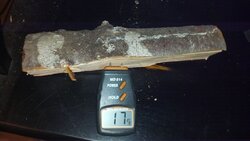I was at Lowe's tonight looking for mini-blinds, and walked down the aisle where the moisture meters were, and I saw them. It was game over. I paid $29.99 for a General brand, and never did get the mini-blinds. I got home, and took out my new toy to play with. I was very surprised what I saw.
I took a few pieces of "seasoned" white oak that was cut/split Dec 2010 (live oak trees before a tornado Dec 2010), and whacked them in half with the maul, and put the moisture meter up to the fresh split sides. All readings were between 22% and 27% WOW! No wonder they are slow to start! I was very surprised. I was guessing none would be over 20%. Now I know oak DOES take two years to season. I can't wait to try my next year's oak that will have almost 2 years season time on them next winter. I bet I will notice a huge difference.
I took a few pieces of "seasoned" Douglas fir that was cut green/split March 2011, whacked them in half, and got 15% to 16% off the fresh split sides. That was surprising too, because the readings were a bit lower than I anticipated. I was guessing 18%-20%.
I whacked open a few green Douglas fir splits I cut a few weeks ago, and the readings were between 34% and 37%. Nothing surprising here.
Finally, I whacked a green piece of photinia wood I cut down live yesterday, and it was 43%, very interesting! The wood is very heavy, no wonder. I have never heard of anyone burning this kind of wood. Maybe it's a great hardwood, like ash or oak!
I took a few pieces of "seasoned" white oak that was cut/split Dec 2010 (live oak trees before a tornado Dec 2010), and whacked them in half with the maul, and put the moisture meter up to the fresh split sides. All readings were between 22% and 27% WOW! No wonder they are slow to start! I was very surprised. I was guessing none would be over 20%. Now I know oak DOES take two years to season. I can't wait to try my next year's oak that will have almost 2 years season time on them next winter. I bet I will notice a huge difference.
I took a few pieces of "seasoned" Douglas fir that was cut green/split March 2011, whacked them in half, and got 15% to 16% off the fresh split sides. That was surprising too, because the readings were a bit lower than I anticipated. I was guessing 18%-20%.
I whacked open a few green Douglas fir splits I cut a few weeks ago, and the readings were between 34% and 37%. Nothing surprising here.
Finally, I whacked a green piece of photinia wood I cut down live yesterday, and it was 43%, very interesting! The wood is very heavy, no wonder. I have never heard of anyone burning this kind of wood. Maybe it's a great hardwood, like ash or oak!


 Burns very nicely, noticeably better than the dead standing oak that reads 18-19%.
Burns very nicely, noticeably better than the dead standing oak that reads 18-19%.